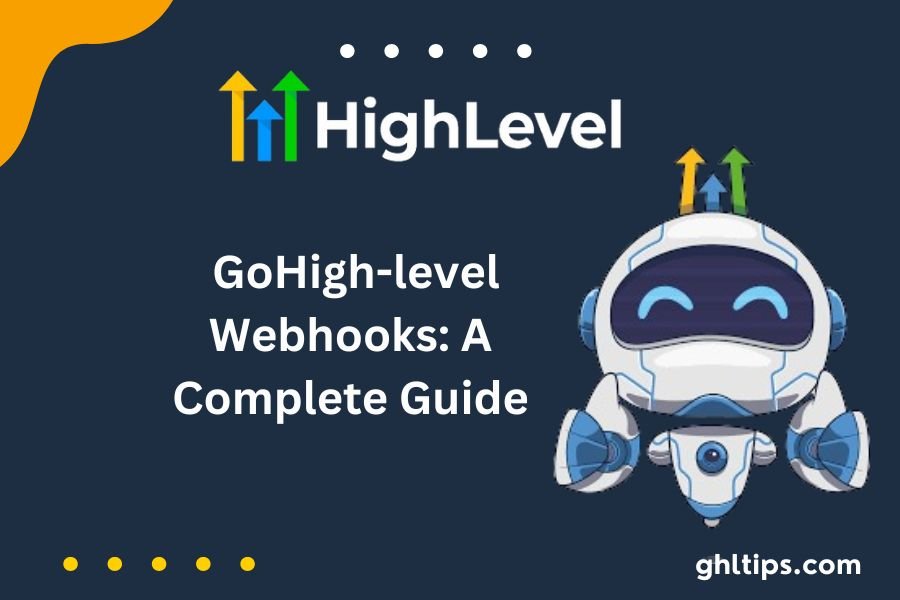Does your business need integration and automation to push it to a new GoHigh-level Webhooks? If it is the functionality of hooks you need, then high-level is the solution you are looking at. With the robust set of tools and functionalities offered by High Level, it becomes possible to make the best use of automation and integration to unblock the immense potential inside your business process and boost your productivity rates.
By creating unique workflows and automation, the automated processes will eliminate repetition, boost data synchronization, and enhance communication among platforms.
It could be Go High-Level integrations with your CRM, email marketing software, or other software business; webhooks lets you do that. Steadily concentrate on your primary business functions, allowing us to carry out all the extracting and synchronizing of the data.
This article will explore how GoHigh-level Webhooks can make your business running processes as simple as possible. This judges the reports of automation and the significant participation in all the activities of the Company planet and soars to new heights with High Level. Get set to unveil the next level of unsurpassed speed and output using Go High-Level webhooks.
- Understanding The Basics Of Webhooks
- Benefits Of Using High-Level Webhooks
- How To Set Up Go High-Level Webhooks
- Everyday Use Cases For High-Level Webhooks
- Best Practices for Implementing High-Level Webhooks
- Integrating Go High-Level Webhooks With Other Tools And Platforms
- Troubleshooting Common Issues With Go High-Level Webhooks
- High-level Webhooks Vs Other Automation And Integration Tools
- Conclusion: GoHigh-level Webhooks
- FAQs
Understanding The Basics Of Webhooks
Before you start working with High-Level webhooks, you should get familiar with the specifics first. First, let’s clarify the question. What webhooks? In plain language, webhooks can be attributed to mechanisms when one application sends data instantly to another when receiving a specific trigger event.
The notification feature at the High Level is just like telling the platform to provide the data to another application through the Internet when a particular trigger happens. Moreover, the lead can be new in your CRM system, apart from form submission on your website or anything else you would want to track and act on.
Webhooks operate on an easy concept of a POST request to a predefined URL to which the data related to what is going on will be sent. After that, the other application processes the data and takes the rightful steps.
To connect a webhook to Go High Level, you need to provide a URL to where the data will be passed, set up an event that triggers the webhook, and configure any other parameters like authentication, if needed.
Benefits Of Using High-Level Webhooks
Now that you understand webhooks let’s explore the benefits of using High Level webhooks for your business.
1. Automation and Efficiency: High-level webhooks allow you to automate time-consuming tasks and keep pace with the evolving demands of doing business. Integrating the Go High-Level platform with programs and services will help you save data entry time, avoid mistakes, and save your team time to focus on what matters.
2. Real-Time Data Syncing: We ensure that the data is always up to date through High-Level webhooks so that it can be synchronized and functioning across various platforms. For example, you can have an opportunity brought over by one of your digital channels synced with your CRM or an updated email list sent to your marketing software provider with no manual input required.
3. Improved Communication: The high-level webhooks’ ability to connect the platform with other tools and interfaces ensures that the information is transferred in the most user-friendly and convenient form. Think of this as a friendly reminder. When a client is added to our system, we can immediately notify the team with a Slack message or run a sequence of actions through our central marketing automation platform. This promotes the collective effort and brings to the ultimate result that everyone is fully operating.
4. Flexibility and Customization: The ease of high-level webhooks gives you the flexibility of tailoring your integration to your business needs without any struggle. With webhooks, you can define which events instigate the hooks, write the data that propagates, and even attach additional parameters to refine the process further. Such a feature boosts, to a great extent, your ability to build highly customized and effective automated workflows that will satisfy exactly your individual needs.
How To Set Up Go High-Level Webhooks
Setting up Go High-Level webhooks is a straightforward process. Follow these steps to get started:
1. Step 1: Create a Webhook Endpoint: To configure a webhook at a High Level, you will first need to develop an endpoint to which the data will be sent. It can be a URL on your website or a landing added to a web app. Ensure that the endpoint is accessible and conformable to webhook requests. Otherwise, the webhook integration will not function properly.
2. Step 2: Define the Webhook of your High Lev: Log into the Go High-Level account, choose the “Webhooks” section, and after that, click “New Webhook”. Just provide the name, URL address, and place where the data should be delivered. Apart from this, we can choose the event that causes the webHook and the possible conditions to add any additional parameters or authentication rules.
3. Step 3: Check and Confirm Webhook Configurations: When you are done configuring your webhook, it is necessary to ensure it works correctly by testing and verifying the webhook configurations. The service that Goes High-Level objects sends enables you to send a mock message to the webhook endpoint and confirm that the way it is received is as expected.
4. Step 4: Set the Webhook Actions: Now, begin testing and verifying the webhook to get a list of actions that need to go on at the receiving end. This procedure might perform some processing on data, bringing an update to the database or sending notifications. Otherwise, the application can be written to do any specific action based on the actual Webhook data.
By following these steps, you can set up and start using High-Level webhooks to automate and integrate your business processes effectively.
Everyday Use Cases For High-Level Webhooks
We can envision endless use cases for High-Level webhooks for automation and integration. Here are some everyday use cases to show you how to leverage webhooks to streamline your business operations. Here are some typical use cases to provide you with an idea of how you can leverage webhooks to simplify your business operations:
1. CRM Integration: Part of High Level integrates with your CRM to achieve a 2-way sync. Thus, you can update information about your customer and trigger follow-up actions ahead of High Level. Another illustrative example can be the auto-creation of a new contact in the CRM when a lead appears in High Level or an updating lead status in High Level when the deal is won.
2. Email Marketing Automation: Organize the level with your email marketing platform to operate your email campaigns on autopilot. For example, newly led interests can be automatically tagged into specific email lists, and customized communications can be sent via personalized emails based on a subscriber’s particular actions. High level can also update the email preference whenever a subscriber unsubscribes from your emails.
3. E-commerce Integration: The Go High-Level service can work with the email marketing efforts of e-commerce business platforms. The system also allows you to deliver automated order fulfillment, inventory updates, and customer communication. For instance, when a customer orders wear from the website, you can reorder the range of wear in your inventory of Higher Level and send a confirmation email to update the customer on the order.
This shows a few of them why there are infinite prospects. Why Pay-level webhooks enable you to build specific supportive flows to automate your business processes.
Best Practices for Implementing High-Level Webhooks
To ensure a smooth and successful implementation of Go High-Level webhooks, consider the following best practices:
1. Plan Your Workflows: During the webhook setup, take some moments to plan and draw the workflow flows. Set up what event you are willing to have the webhook triggered on, define the data you would like to send, and establish what actions you are ready to take based on the data. Simultaneously, this will help you make a more efficient process that is streamlined simultaneously.
2. Test and Verify: Your webhooks must be carefully tested before committing them to the production environment. Upon the availability of the Go High-Level test feature, you may request to send a test payload and check to see if your transmitted data is received as expected. This will show you if any issues occurred or were made before it could affect your business operations.
3. Monitor and Maintain: When you are all done with the webhook setup, however, it is crucially necessary that you constantly keep track of these and ensure that they continue to function reliably. Keep a close tab on error logs, hunt for the cause of failed requests, and make consistent adjustments or updates to your webhooks as your business moves into the future.
Integrating Go High-Level Webhooks With Other Tools And Platforms
High-level webhooks can be seamlessly integrated with a wide range of tools and platforms, enabling you to create powerful automated workflows across your entire tech stack. Here are some popular integrations:
1. CRM Integration: Connect High level with CRMs like Salesforce, HubSpot, or Zoho CRM to keep customer details in sync, update contacts after events, and run certain actions automatically when a customer meets a particular criteria.
2. Email Marketing Software: Link up Go High Level with the email marketing platforms, including Mailchimp, ActiveCampaign, and ConvertKit, to simplify your email campaign automation process and keep data on the subscriber list up to date.
3. Project Management Tools: Link up with other project management tools such as Asana, Trello, or Monday.com, which would then translate into tasks, assign people involved, and track the project’s overall progress.
4. Payment Gateways: If you hold an e-commerce enterprise, You can easily integrate Go High-Level A.I. to payment gateways like Stripe and Paypal A.I. to automate order processing, update payment statuses, and taunt customers.
Troubleshooting Common Issues With Go High-Level Webhooks
While Go High-Level webhooks are robust and reliable, you may encounter some common issues. Here are a few troubleshooting tips to help you resolve them:
1. Check Endpoint Configuration: Review your webhook endpoint’s coding, ensuring the URLs, parameters, and authentication requirements are correct. Check that the target is available and can manage requests arriving as webhooks.
2. Verify Webhook Triggers: If the webhooks are not approving the events, check the events system to ensure it is correctly set up via the Go High-Level webhook. Pick whether the event is public or private; agree upon conditions.
3. Inspect Request and Response Logs: The primary goal is to analyze the request and response logs delivered by High Level to scrutinize the data in transit. See if anything looks suspicious or misaligned that would hamper proper functioning, then sort out all the problems.
4. Test with Sample Payloads: If you’re experiencing issues with your webhook endpoint, you can try sample payloads to check if you can isolate the issue on the endpoint by itself. This way, you’ll discover if the problem lies with High Level or an application you’ve been using to communicate with the platform.
High-level Webhooks Vs Other Automation And Integration Tools
Automation and integration tools often feel like a one-size-fits-all approach, but the Go High-Level webhooks have some unique edge over the rest. Here’s how to Go High-Level webhooks stack up against the competition: Here’s how to Go High-Level webhooks stack up against the competition:
1. Ease of Use: high-level webhooks are meant to integrate smoothly into a user’s workflow. They are deliberately simple to use and set up. The intuitive user interface and the tutorial walkthrough created the system so that everybody could work, including technical and non-technical members.
2. Flexibility and Customization: You are the boss of your automation when you use Go High-Level webhooks to link your software. You can determine the conditions of activation of webhooks, customize the transmitted data, and use custom variables to integrate everything to the needs of your specific solution.
3. Powerful Automation: High-level webhooks help you create robust automated workflows that save you the trouble of clicking around the apps and delaying things. From lead generation to customer onboarding, automation is the way to go, allowing you to carry out repetitive tasks and let yourself focus on more strategic activities.
4. Seamless Integration: High-level webhooks come out of the box with most major platforms and tools, and you can add more. Suppose you already use a popular CRM, project management software, email marketing platform, or checkout solutions. In that case, high-level webhooks allow you to connect and automate such tools and use them for your needs.
Conclusion: GoHigh-level Webhooks
Summing it up GoHigh-level Webhooks can be helpful when businesses try to automate and combine outcomes. Using high-level Webhooks, linking different technologies and services is quickly done.
It allows the smooth implementation of unique work processes and automation. It does this since things tend to run quicker and smoother, and it knows best how to communicate this on other platforms.
GOHigh-level Webhooks allow businesses to execute tasks more straightforwardly and faster, maintaining timely data, facilitating communication, and enabling customization due to their nature.
Thus, the system makes it possible to join the required items, CRM, email marketing, and e-commerce web store, to name a few, based on businesses’ requirements. To set up Go High-Level Webhooks, you need a minimum of s**FAQs: Automation and Integration**
FAQs
What Is Automation?
Automation is the process in which a technology or system can accomplish a job with minimal human interaction. It is the process taken to build workflows and systems that can execute repeatable assignments with a high degree of accuracy.
What Are The Pros Of Automation?
It means agricultural operations will be conducted more promptly, with reduced waste, and using the latest technologies.
What Is Integration?
Integration processes fuse different systems, applications, or technologies to permit them to cooperate efficiently. It closes the gap between other systems by merging their data and functionality, enlarging overall effectiveness and productivity gains.
What Are Automation And Integration In The Business, And In What Way Are They Implemented?
Usually, these platforms serve as email marketing and CRM management systems at the same time. Automated data entry and processing, as well as e-commerce platform integration systems with inventory management systems, are among other practical tools utilized by these platforms.
How Can Automation And Implementation Be Used To Better The Customer’s Experience?
Through automatic systems related to generated services, companies can respond faster, tailor communication, and casing navigation on many touch points. This factors into the customer’s satisfaction level and ultimately leads to customer retention.
How Would AI And Robotics Disrupt Traditional Jobs? What Issues Could Occur As AI Becomes More Integrated Into Our Daily Lives?
Challenges for integration range from conflicts between the systems, information security problems, the need for regular renewal and corrections, the employee’s unwillingness to change, and even system failure in the case of automated processes.
How Can Organizations Lessen Stress Related To Automation And Integration?
Organizations can manage risks by developing robust integration platforms that are tested and validated before implementing automated processes. They should also train employees thoroughly, have strong security measures in place, create a culture of continuous improvement and innovation, and conduct post-implementation evaluations to check out issues that may have arisen.
With Technological Progress, Does Data Collection Play A Part In Automation And Integration?
One of the key areas where data plays a critical role is in automation and integration tasks, where the systems can exchange information, raise actions, and make decisions based on information. Successful automation programs and integrative efforts can only operate with effective data management.
How Do You Estimate The Return On Investment (ROI) Of Automation And Integration Projects In The Business Framework?
Employers can inform ROI by measuring key performance indicators (KPIs): cost savings, productivity growth, error reduction, revenue growth, and client satisfaction boosts.
Follow GHLtips for more Gohigh-level guides!
If you want to learn Gohigh-level from authentic resources then you should have a look at the
courses offered by the GHL academy.







